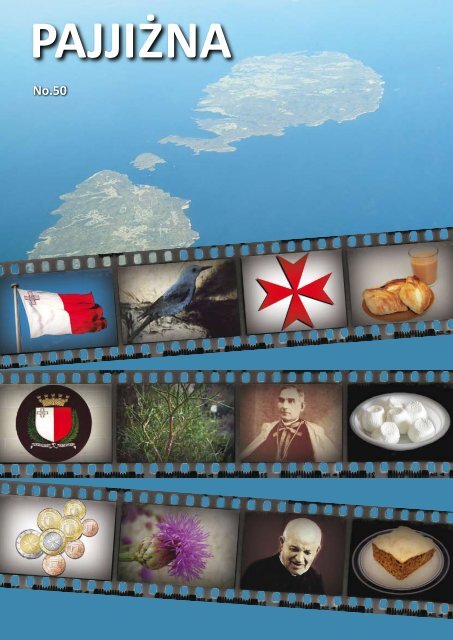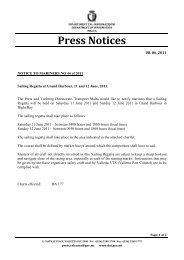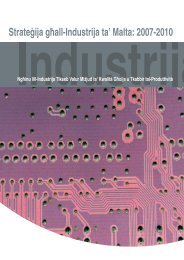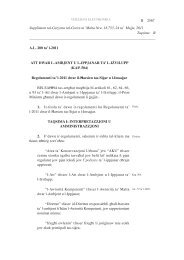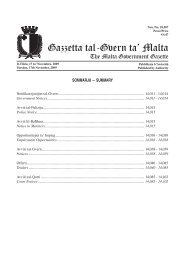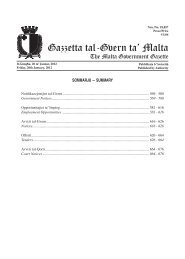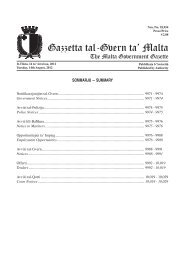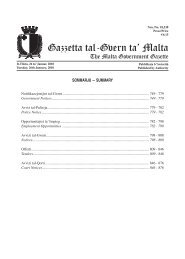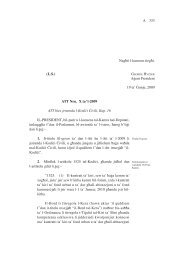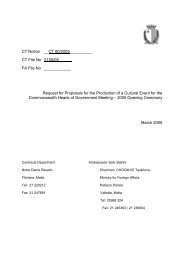You also want an ePaper? Increase the reach of your titles
YUMPU automatically turns print PDFs into web optimized ePapers that Google loves.
PAJJIżNA<br />
No.50
Our Flag<br />
It could be just legend that Count Roger of Normandy gave us our flag as a piece of his red and white chequered<br />
colours, when he came to our islands in 1090. What is fact however is that the Maltese people have always seen this<br />
flag as a symbol of their identity, something which can be witnessed every time this flag is raised.<br />
Upon Independence, the flag also started bearing the George Cross, a medal that King George VI awarded to Malta “…to<br />
bear witness to a heroism and devotion…” that was shown by the maltese population during the Second World War.<br />
The letter, handwritten by King George VI, which<br />
accompanied the George Cross medal sent to Malta<br />
<br />
The George Cross, the medal<br />
awarded to malta during the<br />
Second World War, on the 15<br />
April 1942, as recognition for the<br />
heroism shown by the Maltese<br />
population.
Our Language<br />
Maltese were the first words coming from your lips and Maltese you spoke oh smiling boy. And<br />
that primary language grew with you and became one with your life...(translated from the poem<br />
Ghaliex - Why Dun Karm Psaila.)<br />
The Acts of the Apostles give a first inkling as to what the Maltese<br />
used as a language. The Maltese who welcomed St. Paul on the<br />
Islands were described as barbarians, which in those days meant<br />
people who did not speak Greek or Latin. Most likely they spoke<br />
Punic – that is to say Phoenician and Carthaginian. Hundreds of years<br />
later (AD 832) under Arabic rule, the language imbued the Arabic<br />
dialect. This was retained even after the expulsion of the Moslems<br />
(but not the Arabs) back in 1249. From that year onwards however<br />
one cannot refer to the Arabic articulated in Malta (like the Arabic<br />
conversed in Tunisia or Egypt) but to the Maltese language itself. This<br />
is the point in time where the Maltese language cut off its nexus and<br />
began to reckon with southern Europe particularly Sicily and Italy.<br />
Thus a language, in essence Arabic (having ties with Aramaic used in<br />
Lebanon and Syria), became the parlance of a Catholic and European<br />
community. Maltese continued to be influenced by Romance<br />
elements and this infusion continued throughout the hundreds of<br />
years to come.<br />
The Language Dispute gave rise to a<br />
contention whether Maltese should be<br />
written in Roman letters or go it alone<br />
and use different alphabetical letters.<br />
A definitive resolution was given in 1924<br />
by l-Għaqda tal-Kittieba Maltin (Maltese<br />
Writers Association) in its publication<br />
It-Tagħrif fuq il-Kitba Maltija (Facts on<br />
Maltese Writing) based on rules worked<br />
out by Mikiel Anton Vassalli in 1791.<br />
Scholars felt the need to study and analyse the Maltese language. The<br />
first study of its kind was published in 1750, Della Lingua Punica by<br />
Ġan Franġisk Agius de Soldanis. The Mylsen, the first major grammar<br />
on the language was published by Mikiel Anton Vassalli in 1791, who<br />
also published the first ever Maltese dictionary, Ktieb il-Kliem Malti,<br />
back in 1796.<br />
In the mid-1900s, the first language groups came into being with the<br />
best authors at that time giving their due to create the first literary<br />
movement. Ludovik Mifsud Tommasi and Ġan Anton Vassallo were<br />
among the first to delve into religious and patriotic poetry and gained<br />
huge popularity.<br />
The Language Dispute established Maltese and <strong>English</strong> as the official<br />
languages in 1934. Maltese is now also one of the official languages of<br />
the European Union.<br />
Recently, mainly because of the interaction with the British<br />
and as a result of modern day developments, <strong>English</strong><br />
words acceded into the Maltese language.<br />
The Maltese Language Act (Chapter 470), enacted<br />
unanimously by the House of Representatives in 2005,<br />
set up the National Council of the Maltese Language with<br />
the function and duty to update and promote the Maltese<br />
language.
Malta’s Coat of Arms<br />
Malta’s coat of arms is made out of a shield showing a heraldic representation of the National Flag of Malta; above<br />
the shield there is a mural golden crown with a sally port and eight turrets (only five are visible), which represent<br />
Malta’s fortifications and indicate a City State; around the shield, there is a wreath consisting of two branches,<br />
with an olive on the right and a palm on the left hand side, symbolising peace and traditionally associated with<br />
Malta, all in their true colours and are joined at the base with a ribbon which is white on one side and red on the<br />
other, on which there are the words Repubblika ta’ Malta (Republic of Malta) in black capital letters.<br />
A Presidential Proclamation<br />
showing the Seal<br />
The National Coat of Arms which is to be found in Parliament<br />
The Seal and the wax used by the Republic of Malta<br />
The law (Emblem and Public Seal of Malta Act, Cap. 253), establishes that<br />
no one can make use, whatever the purpose, or incorporate in any design,<br />
the Maltese Emblem, or any imitation thereof, without the Prime Minister’s<br />
written authority. For administrative purposes, it is used in various colours on<br />
official documents. If utilised by the President, then it is in its proper colours,<br />
while the Prime Minister uses it in gold, when used in other instances such<br />
as letterheads, it is is shown in dark blue, the same being used by Ministers.<br />
The Speaker uses it in green. On Government Departments’ letters and<br />
documents, only the black and white version is used.
Other Flags<br />
Presidential Flag of Malta<br />
The Presidential flag of Malta is made up of a blue background, with Malta’s emblem in the middle and Malta’s cross in<br />
gold in each corner. This was introduced by a Proclamation of the 12 December 1988, which states that this flag should<br />
be flown from the President’s office and official residences and on all other occasions attended by the President.<br />
The Merchant Flag of Malta<br />
The Merchant Flag of Malta is made up of a a white Maltese cross in the middle of a red background with a white<br />
border. This flag has the same proportion of use of red and white as the Maltese National flag. All Maltese or<br />
Maltese-registered ships fly this flag, and in fact, this flag proudly adorns the masts of more than 4000 sea vessels<br />
that sail the seas around the world. Any ship entering Malta’s territorial waters should also fly this flag. The use of<br />
this flag is established by law through the Merchant Shipping Act (Chapter 234).<br />
<br />
The roundel which is displayed on<br />
the wings and fuselage of military<br />
aircraft of the Armed Forces of<br />
Malta
Medals and Awards<br />
There are many Maltese, who of their own accord, alone or together with others, work to increase general wealth<br />
or to mitigate the suffering of their fellow countrymen. Malta recognises these efforts by awarding these people<br />
the Ġieħ ir-Repubblika or the National Order of Merit, a system established in 1975 by means of an Act approved by<br />
Parliament, and which was further reinforced in 1990.<br />
The intention of these honours is not to create an elitist society. There is no special privilege or financial benefit<br />
associated with them. The medals and awards are a symbolic way by which the nation openly acknowledges these<br />
citizens’ merits and abilities in different aspects of life.<br />
Appointments to the National Order of Merit and to the Xirka Ġieħ ir-Repubblika, as well as the awards of the Midalja<br />
għall-Qadi tar-Repubblika are made by the President of Malta on the written advice of the Prime Minister. The<br />
appointment instruments, the emblems and medals are presented by the President in an investiture ceremony which<br />
is held annualy on the 13 December. The names of those awarded are also published in the Government Gazette.<br />
There are various grades and medals that are awarded according to the sector in which the individual or group of<br />
people have contributed, but the aim is always one; that with a symbolic and ongoing way, the country publicly<br />
acknowledges the citizens’ merits and capability in different walks of life.<br />
The late Sir Anthony Mamo awarded the Xirka Ġieħ ir-Repubblika<br />
Xirka Ġieħ ir-Repubblika<br />
The National Order of Merit -<br />
Companion<br />
The National Order of Merit - Official<br />
<br />
Midalja għall-Qadi tar-Repubblika
The Maltese National Anthem<br />
Amongst those symbols which identify our country and nation, we find the National Anthem. This Anthem is one of the most important national symbols our country possesses. In 1922, Colonel Robert Samut composed a short piece of music.<br />
This piece of music fell into the hands of A. V. Laferla, who at the time was Director of primary schools, and who was thinking of appointing someone to write a short anthem for children to sing in <strong>gov</strong>ernment schools. When he heard Samut’s<br />
music, he was touched and it was not long before he spoke to Dun Karm, who agreed to write the verses for this piece of music. This is how the Maltese National Anthem was born – a prayer to God composed of six verses of eleven syllables<br />
each (hendecasyllabic). It was played for the first time on the 3rd of February 1923 during a musical-literary concert organized by the Ghaqda Kittieba tal-Malti in the Manoel Theatre. Further on, the same Anthem was arranged to be played by<br />
a band, and the first band which played it was the Kings’ Own band of Valetta during the National Day in 1936. On the 27th of February 1941, it was officially declared as the National Anthem.<br />
Professor Colonel Robert Samut was born in<br />
Floriana on the 12th of October 1869. He studied<br />
medicine and graduated at the Royal University<br />
of Malta and the University of Edinburgh and was<br />
also awarded a medal for his exceptional ability<br />
in anatomy. He was a Professor of Physiology,<br />
Bacteriology and Pathology at the Royal<br />
University of Malta.<br />
From a young age, he had shown interest in music and had also wished to<br />
study music but his father did not approve and consequently he continued<br />
with his career in medicine. Even though Samut did not study music<br />
professionally, he was very good when it came to melody and composition.<br />
He was a talented piano player and singer as well as a painter.<br />
In 1922, Professor Colonel Robert Samut composed a short piece of music<br />
which was to be the music for the Maltese Anthem.<br />
It is a shame that Professor Colonel Robert Samut did not live long enough<br />
to see the importance his composition achieved, because he died at the age<br />
of 64 in 1934. He lies buried in the Portelli chapel at the Addolorata cemetry.<br />
The Maltese Anthem<br />
Guard her, O Lord, as ever Thou hast guarded,<br />
this Motherland so dear whose name we bear:<br />
Keep her in mind, whom Thou hast made so fair.<br />
May he who rules, for wisdom be regarded,<br />
in master mercy, strength in man increase:<br />
Confirm us all, in unity and peace<br />
Reproduction of a booklet containing the music and verses of the Maltese<br />
National Anthem in Maltese and <strong>English</strong><br />
(Credit: http://schoolnet.<strong>gov</strong>.<strong>mt</strong>)<br />
Dun Karm was born on<br />
the 18th October 1871,<br />
in Żebbuġ. When he<br />
was 23 years old Dun<br />
Karm was ordained<br />
a priest at Saint<br />
John’s Co-Cathedral.<br />
After a few months<br />
he began teaching<br />
at the seminary in<br />
Floriana and later on<br />
in Mdina as well. He<br />
taught various subjects<br />
amongst which were<br />
<strong>English</strong>, Italian and<br />
Latin in the Minor<br />
Seminary, as well as<br />
the History of the<br />
Church and Christian<br />
Archeology to theology<br />
students of the Major<br />
Seminary.<br />
In 1896 Dun Karm<br />
published his first<br />
collection of poems in<br />
Italian, with the title<br />
Foglie d’Allore. This<br />
collection is made up<br />
of 37 poems written when he was between 17 and 24 years of age.<br />
On the 11th of January 1912, after discussions with Mons. Pawl Galea and<br />
Ġużè Muscat Azzopardi, who shared with Dun Karm their idea of publishing<br />
a periodical in Maltese which they were going to call Il-Ħabib, Dun Karm<br />
published his first poem in Maltese. As he writes in this poem, he describes<br />
himself kneeling in front of a figure of Our Lady which he had in his room at<br />
his house in Valletta, and prayed with these same words ‘Dear mother, tell<br />
me what to write; I wish to begin with a poem written for you’ This is how he<br />
wrote the poem entitled ‘In front of figure of Our Lady’.<br />
In 1921 he started to work as an Assistant Librarian in the National Library<br />
at Valletta. Between 1922 and 1923, Dun Karm wrote the Maltese National<br />
Anthem using the music which was earlier composed by Prof. Robert Samut.<br />
Among his works, we find poems such as ‘The Me and beyond him’ (Il-Jien u<br />
Lil hinn minnu) and the sonnet ‘To Dun Mikiel Xerri’ (Lil Dun Mikiel Xerr’). Dun<br />
Karm also compiled a Maltese-<strong>English</strong> dictionary.<br />
Dun Karm died on the 3rd of October 1961 at the age of 90 and is buried at<br />
the cemetry in Żebbuġ.
National Days<br />
A nation goes through various milestones which leave their mark on the lives of the people. As an individual<br />
experiences important phases and predicaments throughout his life, so does a nation. This is why during the year, a<br />
nation recollects those achievements and commemorates events pertaining to its journey in history.<br />
Victory Day, 8th September, 1565,<br />
commemorates the victory of the<br />
Order of Saint John and Maltese over<br />
the Ottoman Empire in the Great<br />
Siege. Thanks to this victory, the<br />
Knights remained on the island and<br />
immediately afterwards began the<br />
construction of a new city, Valletta.<br />
The Sette Giugnio, on the 7th June<br />
1919, four Maltese were killed during<br />
riots in Valletta. As a result of this,<br />
the Maltese regained the right to be<br />
in charge of their own internal affairs<br />
through deputies, who were elected<br />
by the people in Parliament.<br />
Republic Day, on 13th December,<br />
1974, the Maltese cut off all remaining<br />
ties with the United Kingdom with<br />
the appointment of a Maltese Head<br />
of State by means of Constitutional<br />
amendments which made Malta a<br />
Republic. Sir Anthony Mamo was<br />
elected as Malta’s first President.<br />
I n d e p e n d e n c e D ay, 2 1 s t<br />
September, 1964 marks the<br />
day when Malta obtained its<br />
Independence from the United<br />
Kingdom. According to the 1964<br />
Constitution, Malta became a<br />
parliamentary democracy under<br />
the Commonwealth thereby<br />
taking responsibility for the<br />
direction and control of its national<br />
affairs and international relations,<br />
through a Cabinet of Ministers led<br />
by a Maltese Prime Minister.<br />
Freedom Day, 31st March,<br />
1979. The contract permitting<br />
the British to use Malta as a<br />
military base expired and the last<br />
members of the armed forces<br />
based in Malta left.<br />
10
The Blue Rock Thrush<br />
The blue rock thrush was declared the Maltese National bird in 1971 and is protected by law. This bird (Monticola<br />
Solitarius), is one of the few birds which live and nest in the Maltese Islands, mostly on cliffs near the sea, as well<br />
as in valleys and hills.<br />
The male is of a shiny dark blue colour with wings and a tail which are almost black. The female is a bit smaller and<br />
has a totally different colouring from the male, in fact it is grey with tints of brown on her upper side, with white<br />
and grey stripes on her lower side.<br />
These birds eat grasshoppers, snails, worms, beetles and small lizards and live in pairs in the same territory throughout<br />
their whole life. They build their nests in a hole or crack on high cliffs using roots and thin twigs. They lay from four<br />
to eight eggs once or twice a year. The eggs are of a dull light blue colour, at times with small red dots, hatching after<br />
fifteen days. Blue rock thrushes are very wary of humans, whom they nonetheless enchant with their beautiful and<br />
melodic singing.<br />
The Blue Rock Thrush, Malta’s National bird<br />
11
The National Tree and Plant<br />
The Juniper Tree<br />
The Juniper tree is the Maltese National Tree, it is endemic<br />
to Malta, even though it can be found in certain parts of<br />
Spain and Northern Africa as well. It grows mostly in cracks<br />
in cliffs and on barren land. It is not to be found in Gozo or in<br />
Comino, but only in Malta, especially in the Northern part,<br />
where we can find more then a hundred such trees and a<br />
specific place named after it – San Ġwann tal-Għargħar.<br />
It is very similar to the Cypress, is green all year round<br />
and grows up to 15 metres height. The tree’s trunk is of a<br />
reddish brown colour and has a sweet smell, with leaves<br />
like matchsticks, small green and thick, and it produces<br />
small nuts divided in four.<br />
This tree, declared the National tree in 1992, became<br />
protected by law one year later. The Council of Europe<br />
counts it amongst the plants in its list of rare, threatened<br />
and endemic trees in Europe.<br />
The Maltese Rock-Centuary<br />
As it does not grow in any other country in the world in the<br />
way it grows in these islands, this plant was declared the<br />
Maltese National Plant. It is also an endemic plant as it grows only<br />
on these islands, on cliffs in the Southern parts of Malta and Gozo.<br />
This is a plant which grows up to a height of one metre, having thick<br />
long leaves with dark green rounded ends. In Gozo, the leaves are<br />
serrated around the edges, like teeth. It is very abundant at its base<br />
and produces purple flowers which come out of its long stalks from<br />
April to September. During the other months, although it does not<br />
flower, it remains green.<br />
It was studied by Maltese academics Agostino Naudi and Stefano<br />
Zerafa in a scientific manner after they discovered it in 1825. Today,<br />
it is grown in many gardens so it may be enjoyed by everyone.<br />
A Chameleon on a Maltese Rock-Centuary<br />
plant. These animals were introduced in<br />
Malta in the 19th century by protestant<br />
ministers who brought specimens with<br />
them from North Africa, then released<br />
them in their gardens in Saint Julians, from<br />
where they spread throughout Malta.<br />
12
Malta fl-Ewropa<br />
As from the 1 January 2008, Malta became part of the euro zone, and the euro became Malta’s national currency.<br />
The notes are all the same for all countries having the euro as their currency, and each note has a different colour.<br />
On the other hand the coins have one side which is common for all countries, while the other face features the<br />
respective country’s national symbols. The design of this face differs from one country to the other.<br />
Malta underwent a consultation process, where the people were asked to choose designs representing Maltato<br />
feature on the euro coin. Malta’s euros display three separate designs, one featuring the altar at Mnajdra temples<br />
which is featured on the 0.01, 0.02 and 0.05 coins, another one displaying Malta’s National Emblem on the 0.10,<br />
0.20 and 0.50 coins, and another design with the Maltese Cross which can be seen on the 1.00 and 2.00. The<br />
selection for Malta’s euro design was finalised by means of a public consultation, in two stages. In the first stage<br />
of this public consultation, the Maltese public had the opportunity to participate in the process of choosing from<br />
a total of twelve selections, categorised in 4 themes – Malta’s prehistory, Malta’s renaissance, Malta’s identity and<br />
Malta’s archipelago. Each theme had three different selections to choose from.<br />
The four final designs were sent to designer Noel Galea Bason. Mr Galea Bason structured the coins with these<br />
designs, so the public would vote on the best three, and eventually Malta’s coins would be ready. In the second<br />
stage, the public was asked to vote one more time. In this phase, Malta’s cross, Malta’s emblem and Imnajdra’s<br />
altar were declared as the public’s preferred choice.<br />
The Central Bank of Malta issued the final designs on 19 February 2007 and on the 23 October of the same year<br />
the designs were published in the European Union’s official journal.<br />
This is the European flag. It’s<br />
the European Union’s symbol,<br />
as well as a representation of<br />
unity and Europe’s identity<br />
in a wider aspect. The circle<br />
with golden stars represents<br />
solidarity and harmony<br />
among Europe’s nations.<br />
The number of stars does<br />
not reflect the number of<br />
Member States. There are<br />
12 stars because the number<br />
12 is a traditional symbol<br />
of perfection, wealth and<br />
unity. To this effect the<br />
flag was never changed<br />
with the European Union’s<br />
enlargement.<br />
13
Saint Ġorġ Preca<br />
Fr Ġorġ Preca, or Dun Ġorġ as he is affectionately known by all, was born in Valletta<br />
on 12 February 1880. He studied at the Lyceum followed by the Seminary. He was<br />
ordained as priest on 22 December 1906.<br />
Even before his priestly ordination, Fr Ġorġ had felt that the people were in need<br />
of Catholic instruction . Initially he was about to set up a society of permanent<br />
deacons who would be able to help the bishops in the people’s Christian formation.<br />
The Society of Christian Doctrine, mostly known by its motto, M.U.S.E.U.M was<br />
initiated in the first months of 1907, in a small place in Ħamrun. It was quite a<br />
novelty to have working lay people, in charge of the Bible and the theology, going<br />
out in the streets and squares, proclaiming God’s word to everybody in public. After<br />
25 years, Malta’s bishop approved Fr Preca’s society and its structure.<br />
The MUSEUM’s centres (known as Mużew)<br />
started opening around Malta and Gozo.<br />
The need for people’ religious instruction<br />
was greatly felt, since their Christian living<br />
centred mostly on the sacraments and<br />
devotions, without much depth in the<br />
teachings of the Church. The children went<br />
daily to Fr Ġorġ’s centres, since they found,<br />
that apart from having catechists who<br />
helped them in their formation, these were<br />
also of help during leisure time.<br />
From the very beginning, Fr Ġorġ instructed<br />
his catechists to remain unmarried, and to<br />
follow a daily one-hour formation together,<br />
once they have finished instructing both<br />
young and adults.<br />
He also taught through his writings. In spite<br />
of the rivalry between the Italian and the<br />
<strong>English</strong> language, Fr Ġorġ taught and wrote<br />
in Maltese, the people’s language, so that<br />
everyone would understand.<br />
Ninni La Tibkix Iżjed<br />
The popular song “Il-Benniena ta’ Ġesu Bambin”, or “Ninni La Tibkix<br />
Iżjed” as it is more widely known, has been penned by Indri Schembri,<br />
a Jesuit monk, in 1864, for Maltese emigrants in Tunis. However, there<br />
are some who think that there exists an Italian song whose music<br />
bears a resemblance to the Maltese one. The song gained popularity<br />
from the time when the Procession with<br />
baby Jesus organised by the M.U.S.E.U.M<br />
Society started to take place. The verses<br />
are a sign of a great tradition which<br />
is still currently alive, linked with the<br />
knowledge of suffering found within<br />
the Maltese Christmas, centred on<br />
baby Jesus. An interesting thing to<br />
note is the amalgamation between the<br />
Maltese interpretation of humanity and<br />
divinity, the same featured in the cribs<br />
and/or Maltese grottos and in Maltese<br />
Christmas legends.<br />
Ninni la tibkix iżjed, ninni Ġesù Bambin,<br />
ħallieh għalina l-biki għax aħna midinbin.<br />
Ejjew ejjew ja Anġli mis-sema mija mija,<br />
taraw li Ġesù twieled, Bambin ġewwa l-fisqija.<br />
Ninu Ninu tal-Milied<br />
Ommu tagħmel il-qagħqiet<br />
Il-qagħqiet tal-qastanija....<br />
Fr Ġorġ Preca worked hard in order to spread the devotion for the Incarnation<br />
Mystery. He wanted that his members wear a badge with the words Verbum Dei<br />
Caro Factum Est. Since 1921 he started organising a “Procession in honour of baby<br />
Jesus” on Christmas Eve in every town and city. This procession ended up being<br />
one of the traditions of a Maltese Christmas. His desire was that for Christmas<br />
every child attending the Mużew would take home a crib with baby Jesus.<br />
Fr Ġorġ passed away in Santa Venera, where he spent his last few months, on<br />
26 July 1962. His mortal remains are preserved in the crypt at the Society’s<br />
Headquarters in Blata l-Bajda.<br />
The Cause for his beatification which initiated in 1975, came to fruition on<br />
Sunday 3 June, 2007.<br />
Unique footage of the last farewell given to this Maltese Saint in July 1962 (on<br />
DVD) may be obtained from the Department of Information (www.doi.<strong>gov</strong>.<strong>mt</strong>),<br />
3, Castille Place, Valletta, Tel: 22001701.<br />
14
Maltese....Too!<br />
The Compact Oxford <strong>English</strong> Dictionary (Second Edition) 1991<br />
15
Production: Publications Unit of the Department of Information<br />
Photos: Photography Section of the Department of Information<br />
Tel. 22001700; website: www.doi.<strong>gov</strong>.<strong>mt</strong>; e-mail: info.doi@<strong>gov</strong>.<strong>mt</strong><br />
Printed on chlorine-free paper at the Government Printing Press<br />
© Department of Information - January 2009


